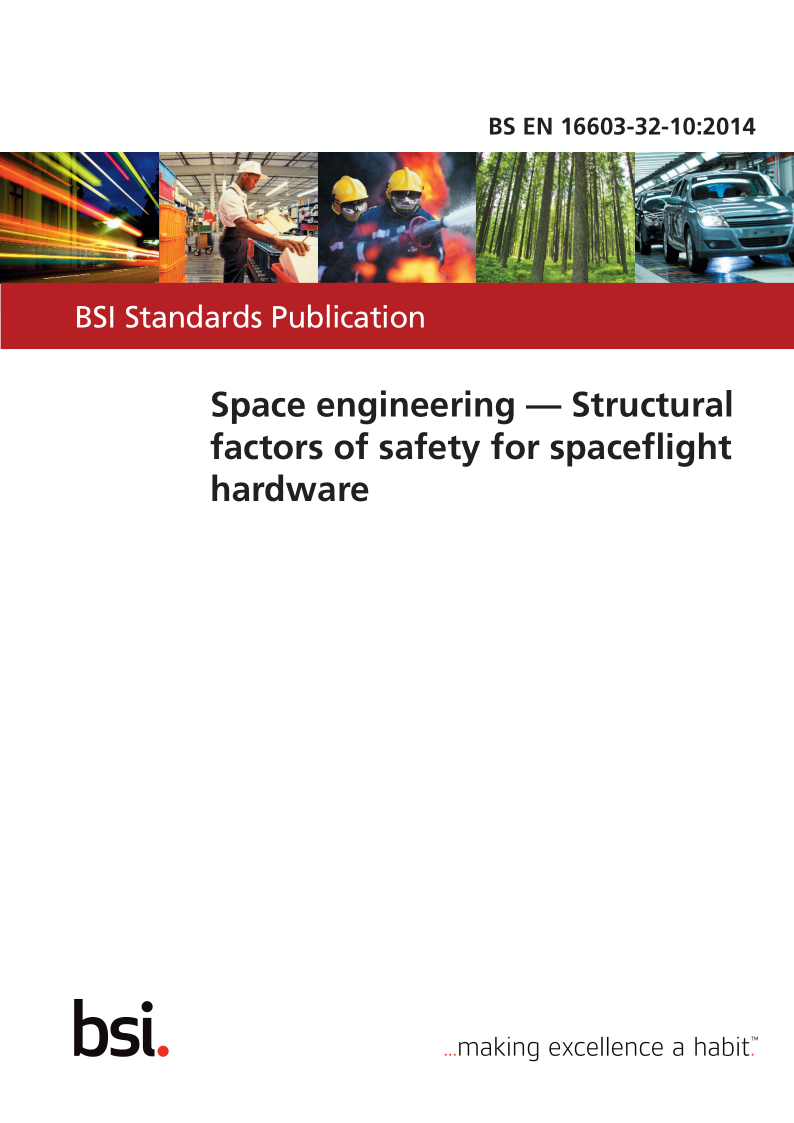标准号:EN 16603-32-10-2014
实施状态:现行
中文名称:航天工程.航空硬件安全性的结构因素
英文名称:Space engineering - Structural factors of safety for spaceflight hardware
发布日期:2014-08
代替标准:FprEN 16603-32-10-2013
采用标准:DIN EN 16603-32-10-2014,IDT;BS EN 16603-32-10-2014,IDT;ECSS-E-ST-32-10C-2009,NEQ;NF L90-300-32-10-2016,IDT;SN EN 16603-32-10-2014,IDT;OENORM EN 16603-32-10-2014,IDT

N-EN 16603-32-10-2014,IDT;SS-EN 16603-32-10-2014,IDT;UNE-EN 16603-32-10-2014,IDT;DS/EN 16603-32-10-2015,IDT;UNI CEI EN 16603-32-10:2015-2015,IDT;STN EN 16603-32-10-2015,IDT;CSN EN 16603-32-10-2015,IDT;DS/EN 16603-32-10-2015,IDT;NEN-EN 16603-32-10:2014 en-2014,IDT;SFS-EN 16603-32-10:en-2014,IDT
标准简介:The purpose of this Standard is to define the Factors Of Safety (FOS), Design Factor and additional factors to be used for the dimensioning and design verification of spaceflight hardware including qualification and acceptance tests. This standard is not self standing and is used in conjunction with the ECSS-E-ST-32, ECSS-E-ST-32-02 and ECSS-E-ST-33-01 documents. Following assumptions are made in the document: - that recognized methodologies are used for the determination of the limit loads, including their scatter, that are applied to the hardware and for the stress analyses; - that the structural and mechanical system design is amenable to engineering analyses by current state-of-the-art methods and is conforming to standard aerospace industry practices. Factors of safety are defined to cover chosen load level probability, assumed uncertainty in mechanical properties and manufacturing but not a lack of engineering effort. The choice of a factor of safety for a program is directly linked to the rationale retained for designing, dimensioning and testing within the program. Therefore, as the development logic and the associated reliability objectives are different for: - unmanned scientific or commercial satellite, - expendable launch vehicles, - man-rated spacecraft, and - any other unmanned space vehicle (e.g. transfer vehicle, planetary probe) specific values are presented for each of them. Factors of safety for re-usable launch vehicles and man-rated commercial spacecraft are not addressed in this document. For all of these space products, factors of safety are defined hereafter in the document whatever the adopted qualification logic: proto-flight or prototype model. For pressurized hardware, factors of safety for all loads except internal pressure loads are defined in this standard. Concerning the internal pressure, the factors of safety for pressurised hardware can be found in ECSS-E-ST-32-02. For loads combination refer to ECSS-E-ST-32-02. For mechanisms, specific factors of safety associated with yield and ultimate of metallic materials, cable rupture factors of safety, stops/shaft shoulders/recess yield factors of safety and limits for peak Hertzian contact stress are specified in ECSS-E-ST-33-01. Alternate approach The factors of safety specified hereafter are applied using a deterministic approach i.e. as generally applied in the Space Industry to achieve the structures standard reliability objectives. Structural safety based on a probabilistic analysis could be an alternate approach but it has to be demonstrated this process achieves the reliability objective specified to the structure. The procedure is approved by the customer. This standard may be tailored for the specific characteristics and constraints of a space project in conformance with ECSS-S-ST-00.
文件格式:PDF
文件大小:1.14MB
文件页数:28
(以上信息更新时间为:2019-11-28)
文档语言及版本参照下方封面截图:

点击下方链接查看更多内容。
 N-EN 16603-32-10-2014,IDT;SS-EN 16603-32-10-2014,IDT;UNE-EN 16603-32-10-2014,IDT;DS/EN 16603-32-10-2015,IDT;UNI CEI EN 16603-32-10:2015-2015,IDT;STN EN 16603-32-10-2015,IDT;CSN EN 16603-32-10-2015,IDT;DS/EN 16603-32-10-2015,IDT;NEN-EN 16603-32-10:2014 en-2014,IDT;SFS-EN 16603-32-10:en-2014,IDT
N-EN 16603-32-10-2014,IDT;SS-EN 16603-32-10-2014,IDT;UNE-EN 16603-32-10-2014,IDT;DS/EN 16603-32-10-2015,IDT;UNI CEI EN 16603-32-10:2015-2015,IDT;STN EN 16603-32-10-2015,IDT;CSN EN 16603-32-10-2015,IDT;DS/EN 16603-32-10-2015,IDT;NEN-EN 16603-32-10:2014 en-2014,IDT;SFS-EN 16603-32-10:en-2014,IDT